Analysis of the Coupling Coordinated Development of the Water-Soil-Energy-Carbon System in Northwest China
Abstract
1. Introduction
2. Method and Data Sources
2.1. Method
2.1.1. Construction of Evaluation Index System for Assessing the Coordinated Development of WLEC System
2.1.2. Evaluation of Safety Development Level within the WLE System
2.1.3. Correlation Analysis
2.1.4. Coupling Coordination Model
2.1.5. Obstacle Degree Model
2.2. Data Sources
3. Results
3.1. Dynamic Changes in the Safety Development Level of the WLE System
3.2. Correlation between the WLE System and the Carbon Emission Subsystem
3.3. Coupling Coordination Degree of the WLEC System
- (Note: Equations (3)–(5) only consider U1, U2, and U3, and the corresponding weights a, b, and c are treated as equal weights)
3.4. The Obstacles to the Coupling Coordinated Development of the WLEC System
4. Discussion
4.1. About the Safety Development Level of the WLE System
4.2. About the Coupling Coordination Degree of the WLEC System
4.3. About the Obstacles to the Coupling Coordinated Development of the WLEC System
4.4. Limitations and Future Research
5. Conclusions
Author Contributions
Funding
Institutional Review Board Statement
Informed Consent Statement
Data Availability Statement
Conflicts of Interest
References
- Zhao, R.Q.; Li, Z.P.; Han, Y.P.; Milind, K.; Zhang, Z.P.; Ding, M.L. The coupling interaction mechanism of regional water-land-energy-carbon system. Acta Geogr. Sin. 2016, 71, 1613–1628. (In Chinese) [Google Scholar]
- Wu, Y.Z.; Deppermann, A.; Havlík, P.; Frank, S.; Ren, M.; Zhao, H.; Ma, L.; Fang, C.; Chen, Q.; Dai, H.C. Global land-use and sustainability implications of enhanced bioenergy import of China. Appl. Energy 2023, 336, 120769. [Google Scholar] [CrossRef]
- Engstrom, R.E.; Destouni, G.; Howells, M.; Ramaswamy, V.; Rogner, H.; Bazilian, M. Cross-scale water and land impacts of local climate and energy policy a local Swedish analysis of selected SDG interactions. Sustainability 2019, 11, 1847. [Google Scholar] [CrossRef]
- Holmatov, B.; Hoekstra, A.Y.; Krol, M.S. Land, water and carbon footprints of circular bioenergy production systems. Renew. Sustain. Energy Rev. 2019, 111, 224–235. [Google Scholar] [CrossRef]
- Sun, C.Z.; Wei, Y.Q.; Zhao, L.S. Co-evolution of water-energy-food nexus in arid areas: Take Northwest China as an example. J. Nat. Resour. 2022, 37, 320–333. (In Chinese) [Google Scholar] [CrossRef]
- Daher, B.; Mohtar, R.H. Water-energy-food (WEF) Nexus Tool 2.0: Guiding integrative resource planning and decision-making. Water Int. 2015, 40, 748–771. [Google Scholar] [CrossRef]
- Li, Y.T.; Wang, Y.H.; Liu, Z.M. Research on the Coupling Coordination Degree of Chinese Cities’ Water-Energy-Food Nexus System and Influencing Factors. J. Ind. Technol. Econ. 2023, 42, 97–105. (In Chinese) [Google Scholar]
- Hoff, H. Understanding the Nexus. In Background Paper for the Bonn 2011 Conference: The Water, Energy and Food Security Nexus; Stockholm Environment Institute: Stockholm, Sweden, 2011. [Google Scholar]
- Wu, Y.T.; Guo, L.D.; Jing, P.R.; Huang, F.; Wang, H.X. Coupling relationship and spatiotemporal differentiation of the water-energy-foodecology nexus in five Central Asian countries. Arid. Zone Res. 2023, 40, 573–582. (In Chinese) [Google Scholar]
- Anez, S. Data-driven quantification of the global water-energy-food system. Resour. Conserv. Recycl. 2018, 133, 179–190. [Google Scholar]
- Hao, L.G.; Yu, J.J.; Wang, P.; Han, C.H. Analysis of the water-energy-food nexus system for sustainable development and its research framework. Prog. Geogr. 2023, 42, 173–184. (In Chinese) [Google Scholar] [CrossRef]
- Liu, J.; Pu, L.; Huang, L.; Shi, T. Research on the Coupling Evaluation and Driving Factors of Water–Energy–Carbon in the Yellow River Basin. Water 2023, 15, 2377. [Google Scholar] [CrossRef]
- Zhao, R.Q.; Yu, Q.; Xiao, L.G.; Sun, J.; Luo, H.L.; Yang, W.J.; Chuai, X.W.; Jiao, S.X. Carbon emissions of urban water system based on water-energy-carbon nexus. Acta Geogr. Sin. 2021, 76, 3119–3134. (In Chinese) [Google Scholar]
- Jiang, W.Y.; Zeng, Z.X.; Zhang, Z.Y. China’s Industrial and Agricultural Carbon Emission Efficiency and Reduction Potential Considering the Water-Land-Energy-Carbon Nexus. Chin. J. Environ. Manag. 2020, 12, 120–129. (In Chinese) [Google Scholar]
- Ahmad, S.; Jia, H.F.; Chen, Z.X.; Li, Q.; Xu, C.Q. Water-energy nexus and energy efficiency: A systematic analysis of urban water systems. Renew. Sustain. Energy Rev. 2020, 134, 110381. [Google Scholar] [CrossRef]
- Wang, J.H.; Zhu, Y.N.; Li, L.H.; Li, J.X.; Jiang, S.; He, G.H. Water–Energy–Carbon Nexus of Social Water Cycle System and Low-Carbon Regulation Strategy. Strateg. Study CAE 2023, 25, 191–201. (In Chinese) [Google Scholar] [CrossRef]
- Wang, B.Q.; Xiao, J.H. Water-energy-carbon nexus in Yangtze River Economic Belt’s inter-provincial trade. J. Econ. Water Resour. 2023, 41, 47–54, 61. (In Chinese) [Google Scholar]
- Tian, P.P.; Lu, H.W.; Reinout, H.; Li, D.; Zhang, K.L.; Yang, Y.Y. Water-energy-carbon nexus in China’s intra and inter-regional trade. Sci. Total Environ. 2022, 806, 150666. [Google Scholar] [CrossRef] [PubMed]
- Lai, L.; Huang, X.J.; Yang, H.; Chuai, X.W.; Zhang, M.; Zhong, T.Y.; Chen, Z.G.; Chen, Y.; Wang, X.; Thompson, J.R. Carbon emissions from land-use change and management in China between 1990 and 2010. Sci Adv. 2016, 2, e1601063. [Google Scholar] [CrossRef]
- Zhang, C.; Tian, H.; Chen, G.; Chappelka, A.; Xu, X.; Ren, W.; Hui, D.; Liu, M.; Lu, C.; Pan, S.; et al. Impacts of urbanization on carbon balance in terrestrial ecosystems of the Southern United States. Environ. Pollut. 2012, 164, 89–101. [Google Scholar] [CrossRef]
- Ali, G.; Nitivattananon, V. Exercising multidisciplinary approach to assess interrelationship between energy use, carbon emission and land use change in a metropolitan city of Pakistan. Renew. Sustain. Energy Rev. 2012, 16, 775–786. [Google Scholar] [CrossRef]
- Zhao, R.; Huang, X.; Liu, Y.; Zhong, T.; Ding, M.; Chuai, X. Carbon emission of regional land use and its decomposition analysis: Case study of Nanjing City, China. Chin. Geogr. Sci. 2015, 25, 198–212. [Google Scholar] [CrossRef]
- Friedlingstein, P.; O’Sullivan, M.; Jones, M.W.; Andrew, R.M.; Hauck, J.; Olsen, A.; Peters, G.P.; Peters, W.; Pongratz, J.; Sitch, S.; et al. Global carbon budget 2020. Earth Syst. Sci. Data 2020, 12, 3269–3340. [Google Scholar] [CrossRef]
- Yang, Q.L.; Zhao, R.Q.; Zhao, T.; Hu, Y.M.; Zhang, Y.P.; Zhu, R.M. Elationship between agricultural carbon emission efficiency and food security at county scale. Chin. J. Agric. Resour. Reg. Plan. 2023, 44, 156–169. (In Chinese) [Google Scholar]
- Enriquez-de-Salamanca, A.; Martin-Aranda, R.M.; Diaz-Sierra, R. Potential of land use activities to offset road traffic greenhouse gas emissions in Central Spain. Sci. Total Environ. 2017, 590, 215–225. [Google Scholar] [CrossRef]
- Skaggs, R.; Hibbard, K.A.; Frumhoff, P.; Lowry, T.; Middleton, R.; Pate, R.; Tidwell, V.C.; Arnold, J.G.; Averyt, K.; Janetos, A.C.; et al. Climate and Energy-Water-Land System Interactions Technical Report to the U.S. Department of Energy in Support of the National Climate Assessment; U.S. Department of Energy Office of Scientific and Technical Information: Richland, WA, USA, 2012. [Google Scholar] [CrossRef]
- Feng, M.Y.; Zhao, R.Q.; Huang, H.P.; Xiao, L.G.; Xie, Z.X.; Zhang, L.J.; Sun, J.; Chuai, X.W. Water–energy–carbon nexus of different land use types: The case of Zhengzhou. China Ecol. Indic. 2022, 141, 10. [Google Scholar] [CrossRef]
- Wang, F.; Cao, Y.Q.; Chen, M.; Yang, Y.F. Network characteristics of water-land-energy-carbon correlation system in the yellow river basin. Adv. Sci. Technol. Water Resour. 2023, 9073, 1–13. (In Chinese) [Google Scholar]
- Zhao, R.Q.; Liu, Y.; Tian, M.M.; Ding, M.L.; Cao, L.H.; Zhang, Z.P.; Chuai, X.W.; Xiao, L.G.; Yao, L.G. Impacts of water and land resources exploitation on agricultural carbon emissions: The water-land-energy-carbon nexus. Land Use Policy 2018, 72, 480–492. [Google Scholar] [CrossRef]
- Jiang, W.Y.; Zhang, Z.Y.; Wen, J.; Yin, L.F.; Song, B.K. Spatio-temporal variation and influencing factors of industrial carbon emission effect in China based on water-land-energy-carbon nexus. Ecol. Indic. 2023, 152, 110307. [Google Scholar] [CrossRef]
- Venkatesh, D.; Chan, A.; Brattebo, H. Understanding the water-energy-carbon nexus in urban water utilities: Comparison of four city case studies and the relevant influencing factors. Energy 2014, 75, 153–166. [Google Scholar] [CrossRef]
- Watanabe, M.D.B.; Ortega, E. Dynamic emergy accounting of water and carbon ecosystem services: A model to simulate the impacts of land-use change. Ecol. Model. 2014, 271, 113–131. [Google Scholar] [CrossRef]
- Cheng, L.; Tian, J.; Xu, H.; Chen, L. Unveiling the Nexus Profile of Embodied Water–Energy–Carbon–Value Flows of the Yellow River Basin in China. Environ. Sci. Technol. 2023, 57, 8568–8577. (In Chinese) [Google Scholar] [CrossRef] [PubMed]
- Sun, J.; Liu, Y.; Zhao, R.Q.; Yang, W.J.; Wu, H.X.; Peng, C.Y.; Guo, M.; Liu, K. The flow analysis of inter-provincial agricultural water, land and carbon footprints in China based on input-output model. Acta Ecol. Sin. 2022, 42, 9615–9626. (In Chinese) [Google Scholar]
- Ren, X.L.; He, H.L.; Liu, M.; Zhang, L.; Zhou, L.; Yu, G.R.; Wang, H.M. Modeling of carbon and water fluxes of Qianyanzhou subtropical coniferous plantation using model-data fusion approach. Acta Ecol. Sin. 2012, 32, 7313–7326. (In Chinese) [Google Scholar]
- Li, G.J.; Huang, D.; Li, Y.L. Water-energy-food correlation: A new perspective of regional sustainable development research. J. Cent. Univ. Financ. Econ. 2016, 12, 76–90. (In Chinese) [Google Scholar]
- Li, M.Q.; Zhang, J.J.; Song, R.; Fu, B.N. Spatial-temporal Evolution of Sustainable Development Level and Industrial Development Scale in Urban China. Stat. Decis. 2021, 37, 93–97. (In Chinese) [Google Scholar]
- CPC Central Committee and State Council. National New Urbanization Plan (2014–2020); CPC Central Committee and State Council: Beijing, China, 2023. [Google Scholar]
- Chen, X.L.; Di, Q.B. Spatial connection and radiation effect of regional high-quality development: A case study of the Liaoning coastal economic belt. Prog. Geogr. 2014, 42, 2126–2142. [Google Scholar] [CrossRef]
- Liu, H.; Zhang, Y.; Zheng, W.S. Evaluation of spatio-temporal coupling and coordinated development of urban land intensive use and regional urbanization: A case study of cities in bohai rim region. Geogr. Res. 2011, 30, 1805–1817. [Google Scholar]
- Lin, S.G.; Lu, R.C.; Liu, S.K.; Ye, Z.D.; Wei, Q.T.; Luo, J.L. Land use pattern and multifunctional evolution in the border areas in the Guangxi Zhuang Autonomous Region based on “production-living-ecosystem” space. Trans. Chin. Soc. Agric. Eng. 2021, 1817, 265–274. [Google Scholar]
- Wang, M.; Wang, P.; Liang, W.U.; Yang, R.P.; Feng, X.Z.; Zhao, M.X.; Du, X.L.; Wang, Y.Y. Criteria for assessing carbon emissions peaks at provincial level in China. Adv. Clim. Change Res. 2022, 13, 131–137. [Google Scholar] [CrossRef]
- Xu, S.; He, W.; Shen, J.; Degefu, D.M.; Yuan, L.; Kong, Y. Coupling and coordination degrees of the core water–energy–food nexus in China. Int. J. Environ. Res. Public Health 2019, 16, 1648. [Google Scholar] [CrossRef]
- Zhou, X.; Wu, D.; Li, J.; Liang, J.; Zhang, D.; Chen, W. Cultivated land use efficiency and its driving factors in the Yellow River Basin, China. Ecol. Indic. 2022, 144, 109411. [Google Scholar] [CrossRef]
- Zhang, D.D.; Chang, L.; Wu, S.C.; Cui, Y.Q.; Wang, Y.S.; Zeng, J.J. Study on sustainable development of water resources in Gansu Province. In Proceedings of the 5th International Conference on Water Resource and Environment (WRE 2019), Macao, China, 16–19 July 2019; Volume 344, p. 012164. [Google Scholar]
- Wang, H.; Fang, L. Spatial-temporal coupling coordination relationship between the security level of water-energy-food nexus system and total factor productivity in China. Water Resour. Prot. 2023, 39, 150–157. (In Chinese) [Google Scholar]
- Ren, Q.R.; Yu, E.Y. Coupling analysis on coordinated development of ecological environment and social economic system in Gansu Province. Acta Ecol. Sin. 2021, 41, 2944–2953. (In Chinese) [Google Scholar]
- Ye, S.; Ge, Y.; Xu, S.; Ma, X. Measurement and Prediction of Coupling Coordination Level of Economic Development, Social Stability and Ecological Environment in Qinghai—Thoughts on Sustainable Societal Safety. Sustainability 2022, 14, 10515. [Google Scholar] [CrossRef]
- Jiang, C.; Sun, Q.; Tian, T. Coupling coordination and obstacle analysis of urbanization and water resources in Shaanxi Province. Water Resour. Dev. Manag. 2021, 10, 15–20. [Google Scholar]
- Wang, Z.Q.; Jiang, W.H.; Lu, S.Y. Characteristics of “water-energy-carbon” coupling system in Xinjiang based on the ecological network analysis. Arid Land Geogr. 2023, 46, 2005–2016. (In Chinese) [Google Scholar]
- Teng, W.T.F.; Feng, T.Z.; Guo, D.Y. Drivers and decoupling effects of carbon emissions in Northwest China. J. Beijing Norm. Univ. (Nat. Sci.) 2023, 59, 260–268. (In Chinese) [Google Scholar]
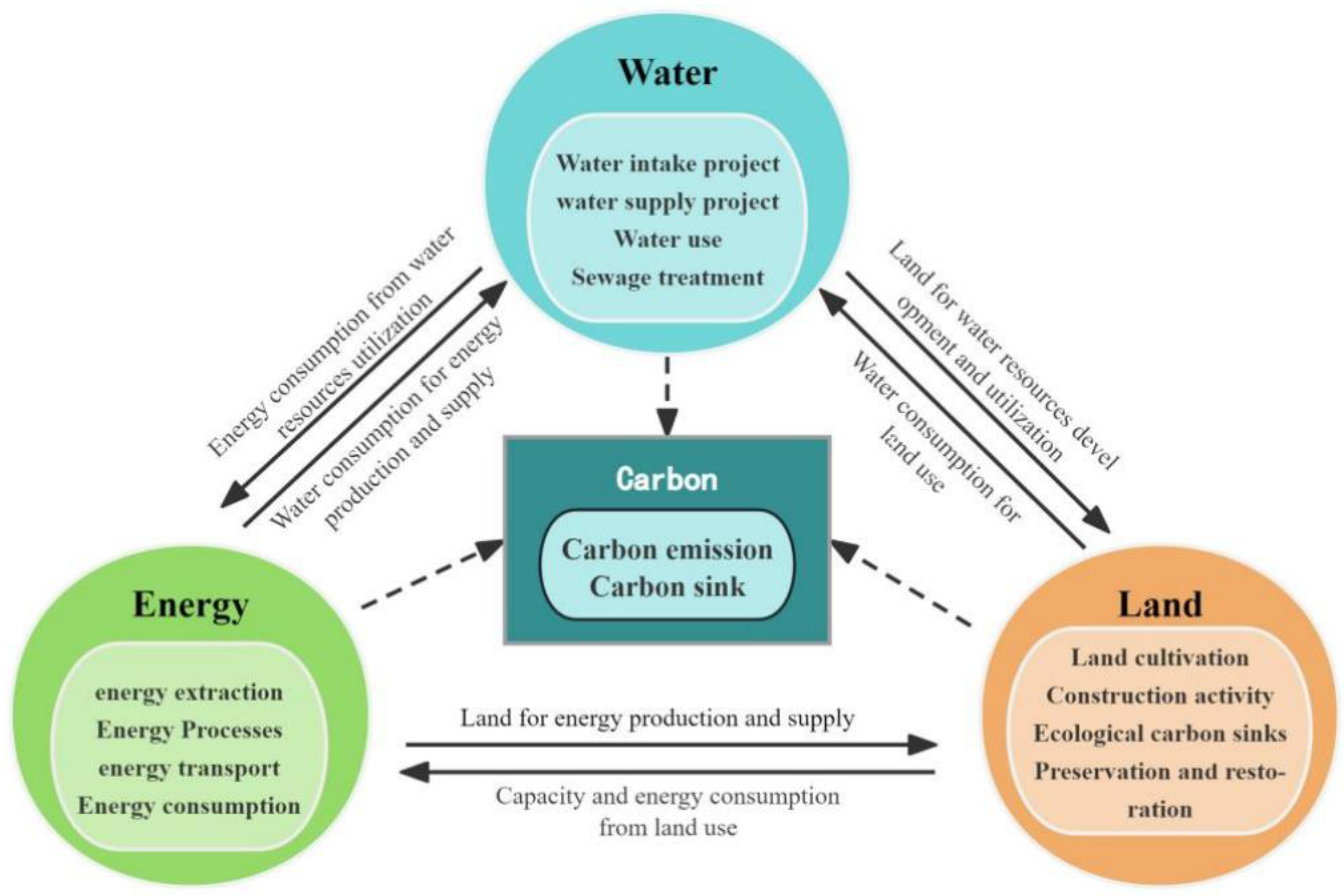
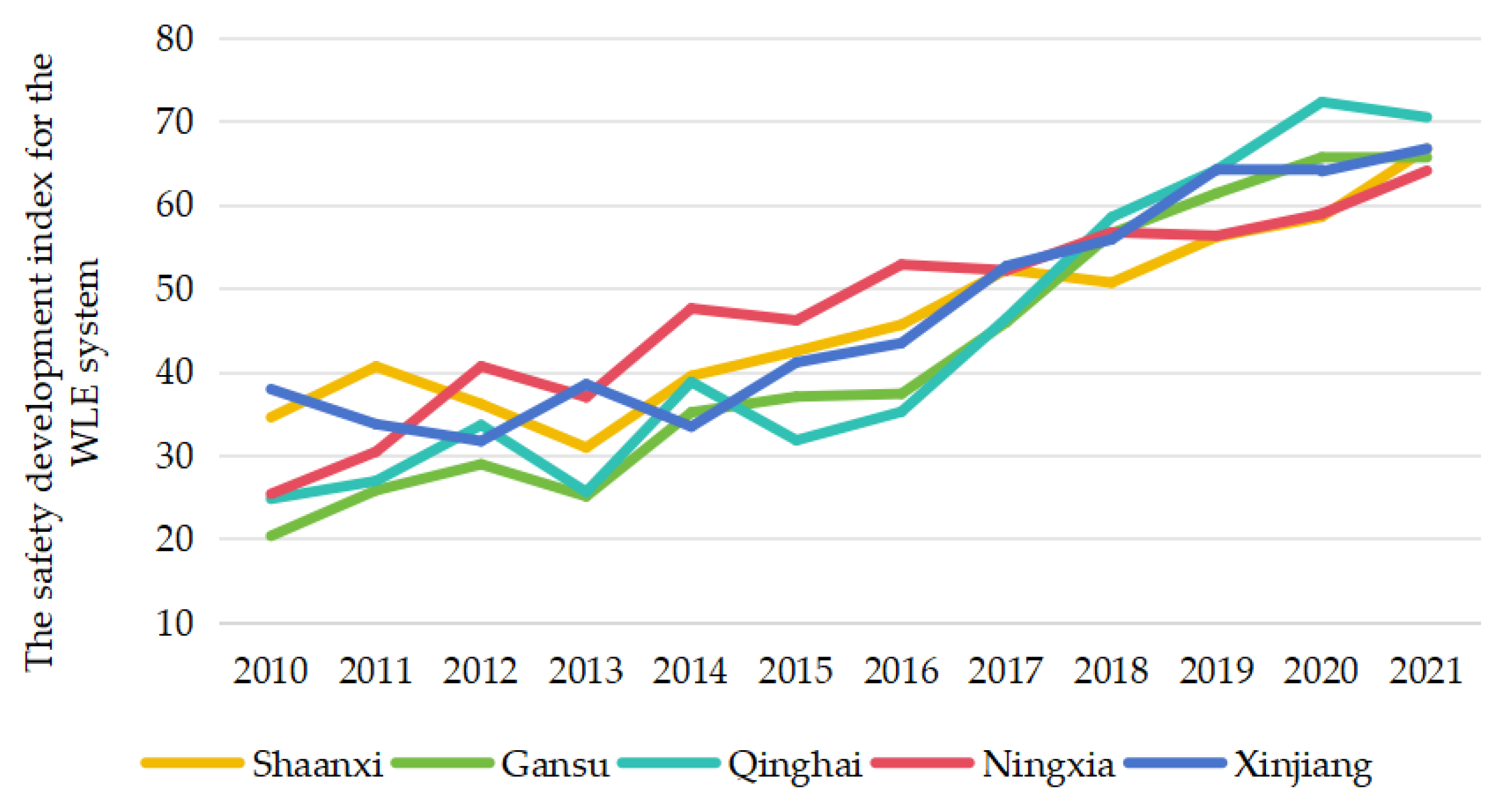
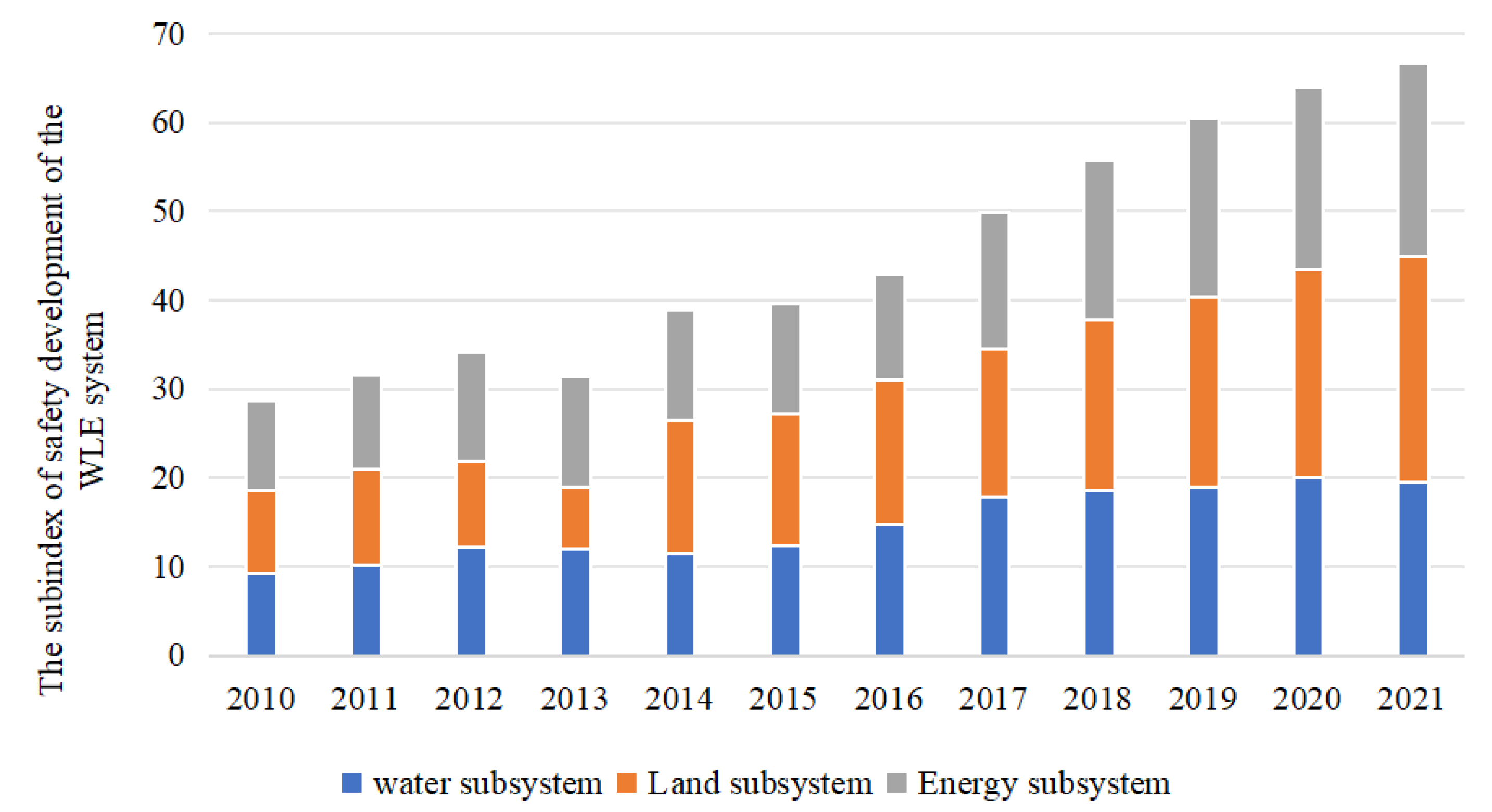
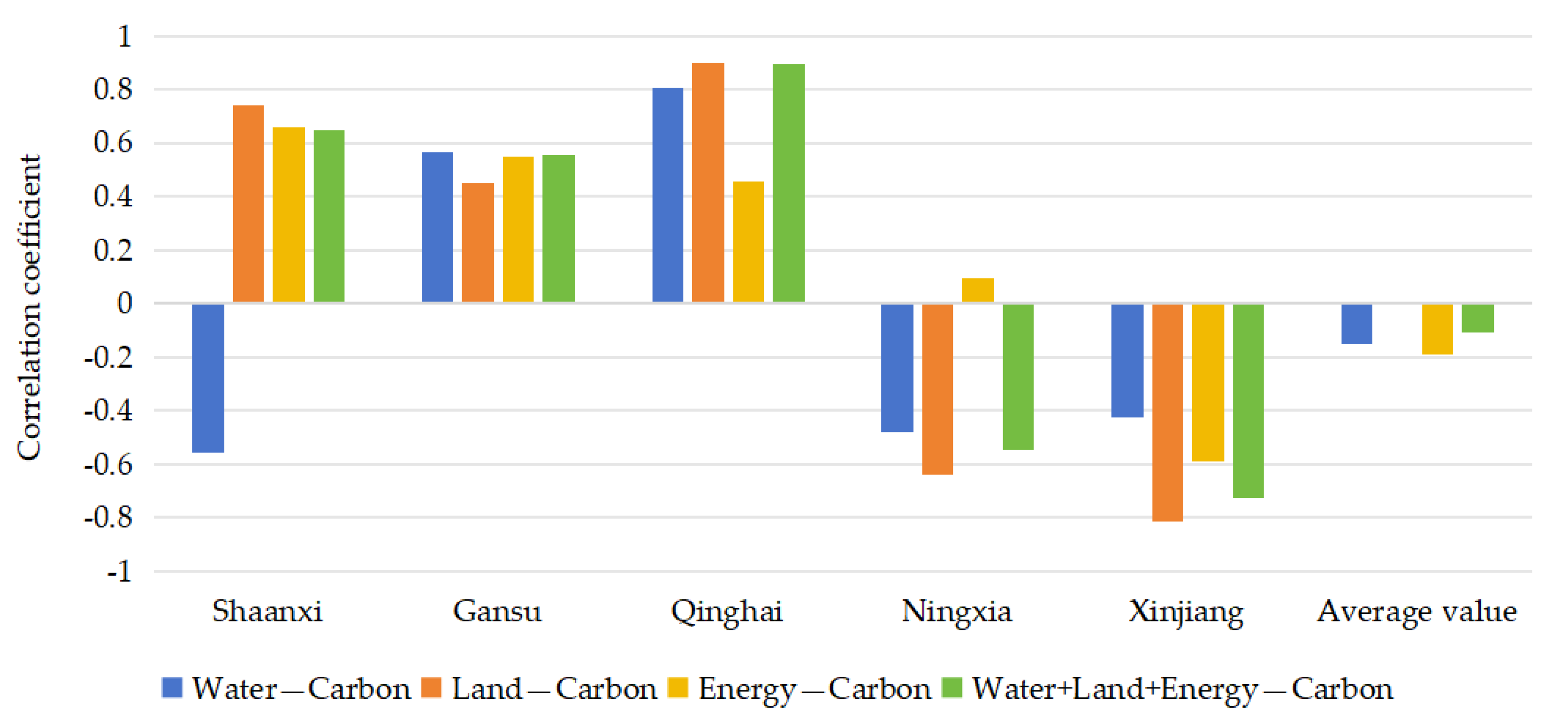
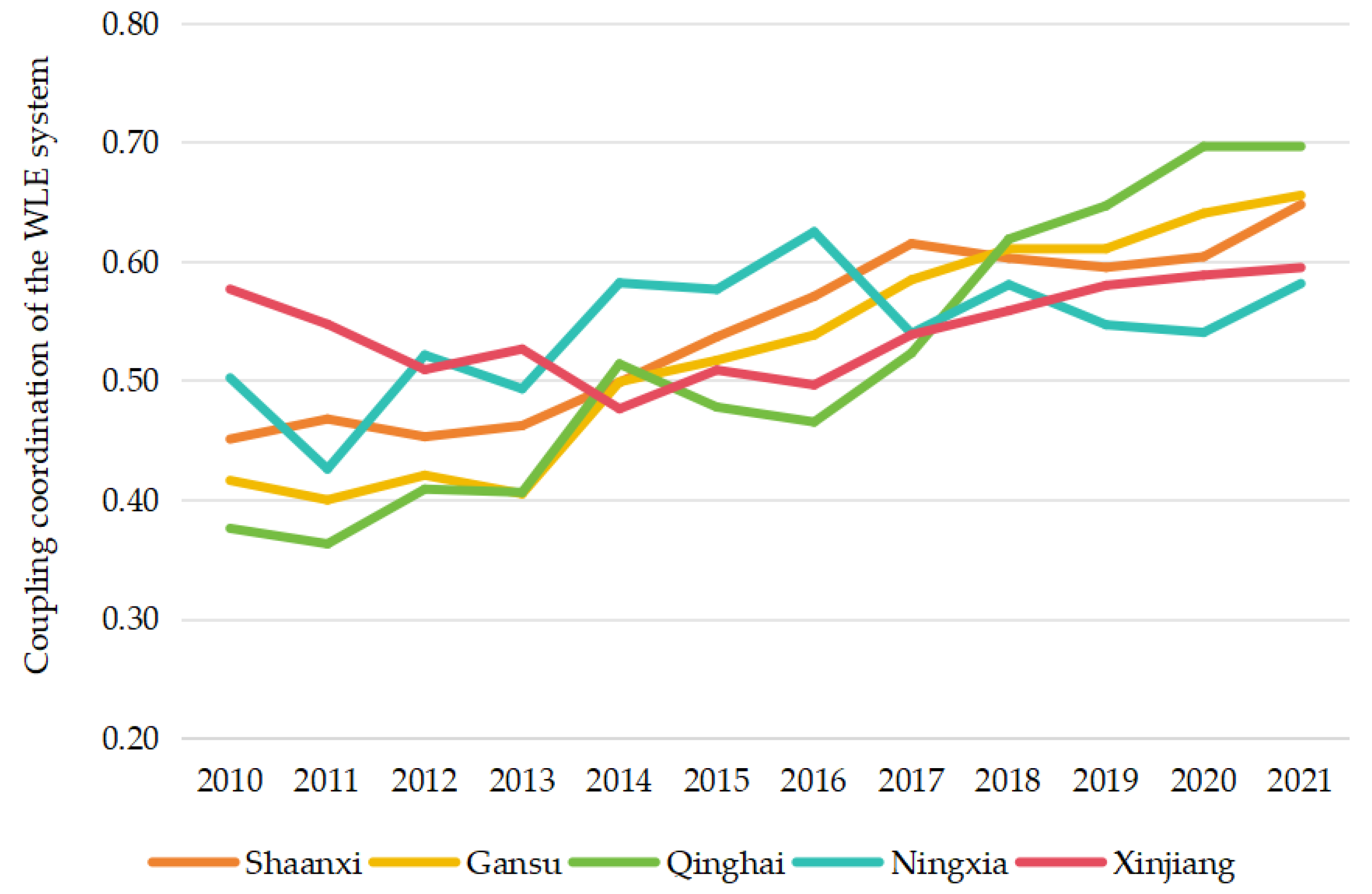
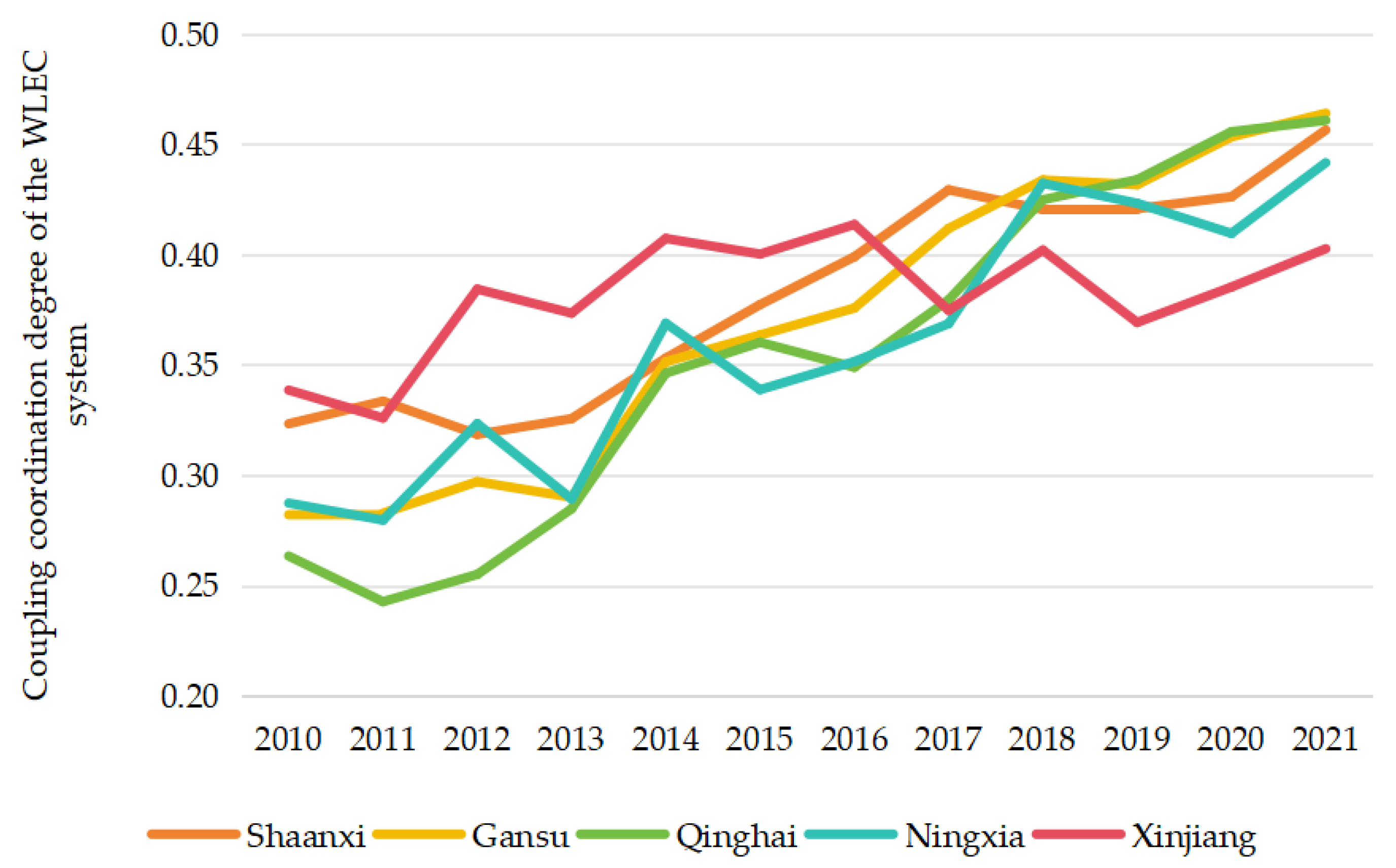
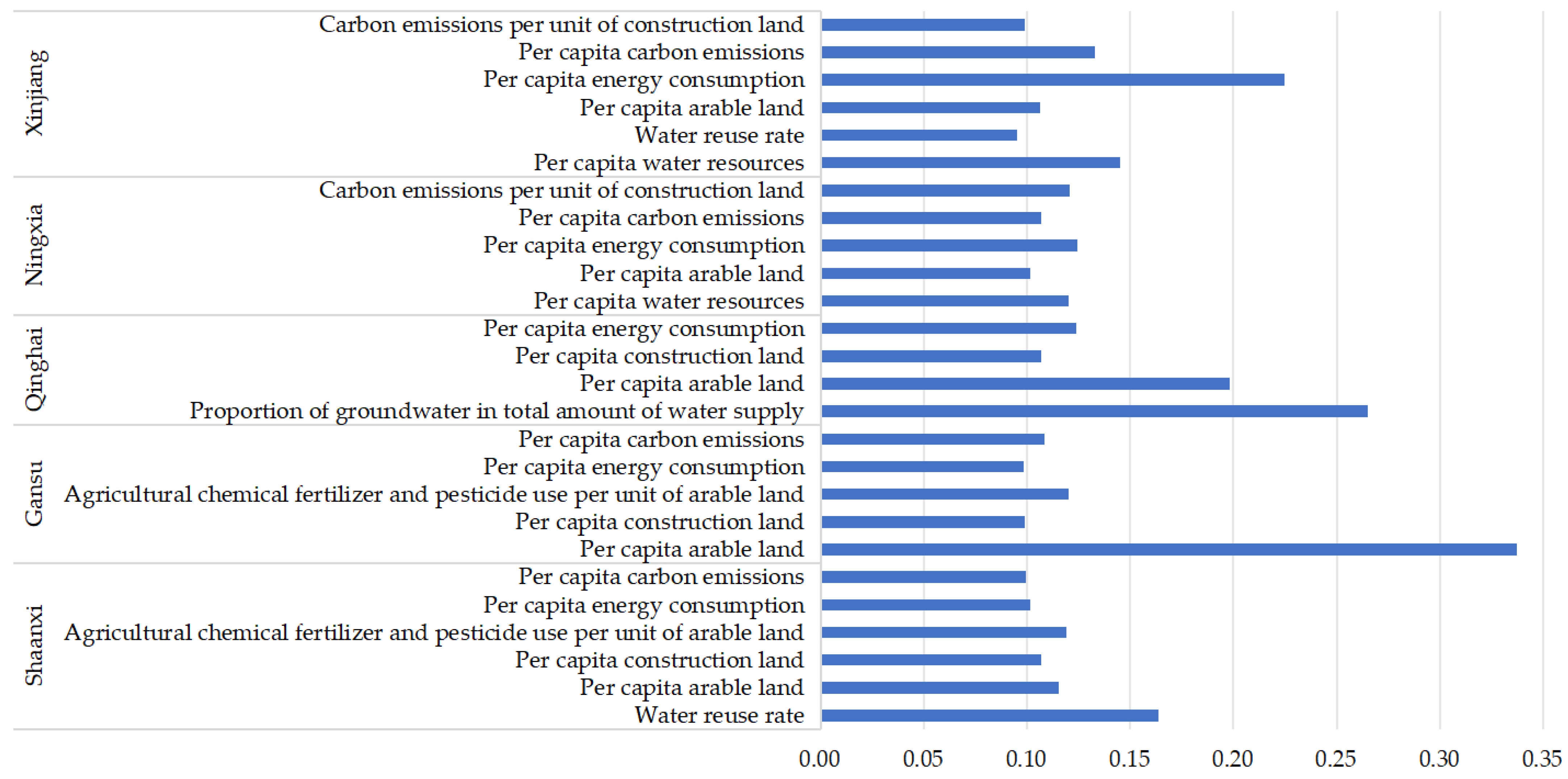
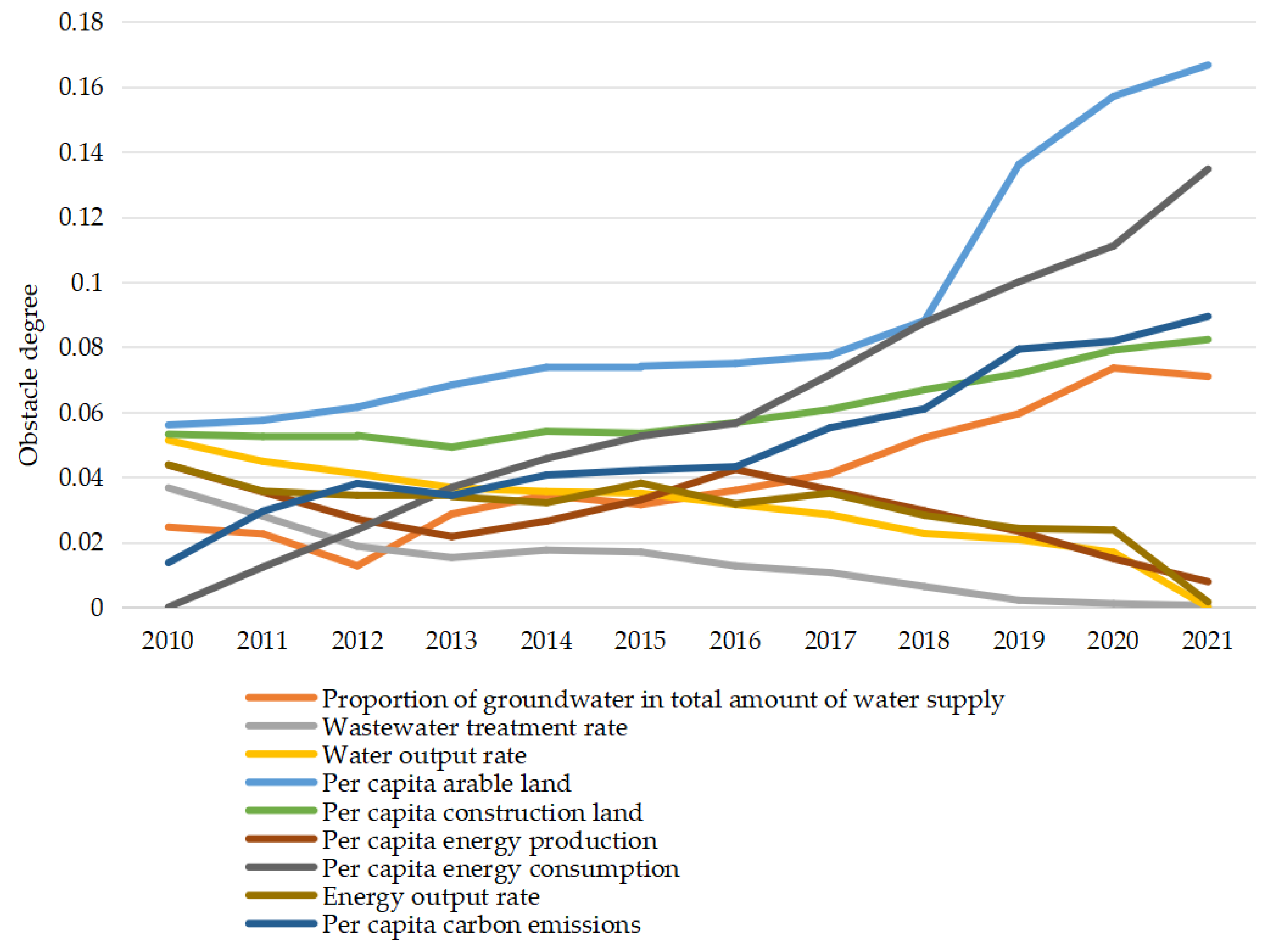
| Primary Indicators | Secondary Indicators | Specific Indicators | Indicator Properties | Weights | ||||
|---|---|---|---|---|---|---|---|---|
| Shaanxi | Gansu | Qinghai | Ningxia | Xinjiang | ||||
| Water | Water supply | Per capita water resources (Cubic meters/person) | Positive | 0.05 | 0.05 | 0.03 | 0.05 | 0.06 |
| Proportion of groundwater in total amount of water supply (%) | Negative | 0.03 | 0.03 | 0.07 | 0.03 | 0.02 | ||
| Water use | Per capita water use (Cubic meters/person) | Negative | 0.06 | 0.06 | 0.03 | 0.05 | 0.03 | |
| Agriculture water use per unit of arable land (Cubic meters/ha) | Negative | 0.03 | 0.04 | 0.04 | 0.04 | 0.03 | ||
| Economical use | Water reuse rate (%) | Positive | 0.06 | 0.02 | 0.10 | 0.04 | 0.04 | |
| Sewage treatment | Wastewater treatment rate (%) | Positive | 0.02 | 0.03 | 0.03 | 0.03 | 0.03 | |
| Water efficiency | Water output rate (Cubic meters/ten thousand Yuan) | Positive | 0.03 | 0.03 | 0.03 | 0.04 | 0.04 | |
| Land | Land supply | Per capita arable land (ha/person) | Moderate | 0.04 | 0.12 | 0.06 | 0.04 | 0.04 |
| Per capita construction land (Square kilometers/person) | Moderate | 0.05 | 0.04 | 0.04 | 0.03 | 0.02 | ||
| Land production | Per capita output of grain crops (Tons/person) | Positive | 0.09 | 0.06 | 0.06 | 0.07 | 0.03 | |
| Output rate of construction land (ha/ten thousand Yuan) | Positive | 0.02 | 0.02 | 0.02 | 0.03 | 0.04 | ||
| Protecting and Enhancing Natural Carbon Sinks | Forest coverage rate (%) | Positive | 0.06 | 0.06 | 0.06 | 0.07 | 0.06 | |
| Control and remediation | Agricultural chemical fertilizer and pesticide use per unit of arable land (Tons/ha) | Negative | 0.04 | 0.04 | 0.07 | 0.03 | 0.07 | |
| Proportion of area of soil erosion under control in total land area administrative region (%) | Positive | 0.04 | 0.06 | 0.07 | 0.04 | 0.04 | ||
| Energy | Energy supply | Per capita energy production (Tons of standard coal/person) | Positive | 0.02 | 0.03 | 0.03 | 0.03 | 0.04 |
| Proportion of non-fossil energy in total primary energy production (%) | Positive | 0.06 | 0.04 | 0.04 | 0.06 | 0.05 | ||
| Proportion renewable energy generation (%) | Positive | 0.06 | 0.03 | 0.03 | 0.04 | 0.03 | ||
| Energy consumption | Per capita energy consumption (Tons of standard coal/person) | Negative | 0.03 | 0.03 | 0.03 | 0.05 | 0.09 | |
| Proportion of Non-fossil Energy in Total Primary Energy Consumption (%) | Positive | 0.06 | 0.05 | 0.02 | 0.04 | 0.05 | ||
| Proportion of Terminal Energy in Total Energy Consumption (%) | Positive | 0.03 | 0.01 | 0.03 | 0.04 | 0.03 | ||
| Energy efficiency | Energy output rate (Tons of standard coal/ten thousand Yuan) | Positive | 0.03 | 0.03 | 0.03 | 0.03 | 0.05 | |
| Carbon emissions | Emissions intensity | Per capita carbon emissions (Tons/person) | Negative | 0.03 | 0.04 | 0.05 | 0.05 | 0.05 |
| Carbon emissions per unit of GDP (Tons/ten thousand Yuan) | Negative | 0.02 | 0.03 | 0.02 | 0.02 | 0.03 | ||
| Carbon emissions per unit of construction land (Tons/square kilometers) | Negative | 0.04 | 0.04 | 0.02 | 0.05 | 0.04 | ||
| Score | Classification |
|---|---|
| WLESDI < 40 | Weak |
| 40 ≤ WLESDI < 60 | Weak–moderate transition |
| 60 ≤ WLESDI < 70 | Moderate |
| 70 ≤ WLESDI < 80 | Moderate–strong transition |
| 80 ≤ WLESDI < 90 | Strong |
| 90 ≤ WLESDI ≤ 100 | Very strong |
| Score | Level Classification |
|---|---|
| 0 ≤ C < 0.1 | Extreme disorder |
| 0.1 ≤ C < 0.2 | Serious disorder |
| 0.2 ≤ C < 0.3 | Moderate disorder |
| 0.3 ≤ C < 0.4 | Low disorder |
| 0.4 ≤ C < 0.5 | Marginal disorder |
| 0.5 ≤ C < 0.6 | Marginal coordination |
| 0.6 ≤ C < 0.7 | Low coordination |
| 0.7 ≤ C < 0.8 | Moderate coordination |
| 0.8 ≤ C < 0.9 | Good coordination |
| 0.9 ≤ C ≤ 1.0 | High coordination |
| Data | Sources |
|---|---|
| Total Amount of Water Resources; Amount of Groundwater Resources; Total Amount of Water Supply; Total Use of Agriculture Water; Arable Land; Forest Coverage Rate | China Statistical Yearbook |
| Water Reuse Rate; Wastewater Treatment Rate; Area of Construction Land; Total Land Area Administrative Region | China Urban Construction Statistical Yearbook |
| Output of Grain Crops; Use of Agricultural Chemical Fertilizer and Pesticide | China Rural Statistical Yearbook |
| Area of Soil Erosion under Control | China Environmental Statistical Yearbook |
| Total Energy Production; Proportion of Non-fossil Energy in Total Primary Energy Production; Total Energy Consumption; Proportion of Non-fossil Energy in Total Primary Energy Consumption | China Energy Statistical Yearbook; Shaanxi Statistical Yearbook; Xinjiang Statistical Yearbook; Qinghai Statistical Yearbook; Ningxia Statistical Yearbook; Gansu development yearbook |
| Permanent Population; Arable Land; Gross Domestic Product (GDP) | China Statistical Yearbook |
Disclaimer/Publisher’s Note: The statements, opinions and data contained in all publications are solely those of the individual author(s) and contributor(s) and not of MDPI and/or the editor(s). MDPI and/or the editor(s) disclaim responsibility for any injury to people or property resulting from any ideas, methods, instructions or products referred to in the content. |
© 2024 by the authors. Licensee MDPI, Basel, Switzerland. This article is an open access article distributed under the terms and conditions of the Creative Commons Attribution (CC BY) license (https://creativecommons.org/licenses/by/4.0/).
Share and Cite
Wang, M.; An, Y.; Yang, R.; Shan, X.; Li, L.; Feng, X. Analysis of the Coupling Coordinated Development of the Water-Soil-Energy-Carbon System in Northwest China. Land 2024, 13, 715. https://doi.org/10.3390/land13050715
Wang M, An Y, Yang R, Shan X, Li L, Feng X. Analysis of the Coupling Coordinated Development of the Water-Soil-Energy-Carbon System in Northwest China. Land. 2024; 13(5):715. https://doi.org/10.3390/land13050715
Chicago/Turabian StyleWang, Min, Yiming An, Rupu Yang, Xiaoyu Shan, Liping Li, and Xiangzhao Feng. 2024. "Analysis of the Coupling Coordinated Development of the Water-Soil-Energy-Carbon System in Northwest China" Land 13, no. 5: 715. https://doi.org/10.3390/land13050715
APA StyleWang, M., An, Y., Yang, R., Shan, X., Li, L., & Feng, X. (2024). Analysis of the Coupling Coordinated Development of the Water-Soil-Energy-Carbon System in Northwest China. Land, 13(5), 715. https://doi.org/10.3390/land13050715







